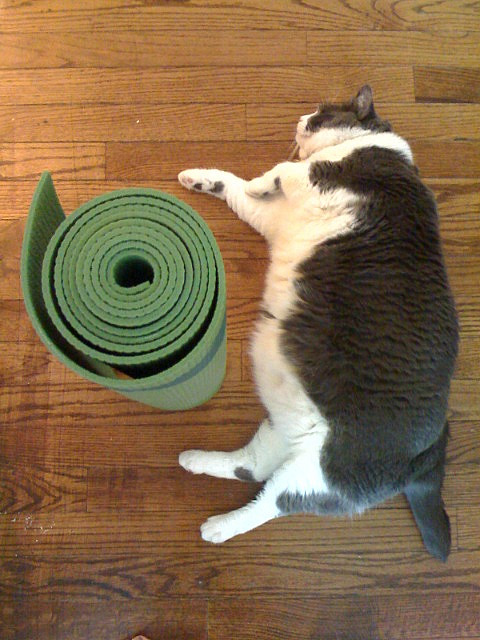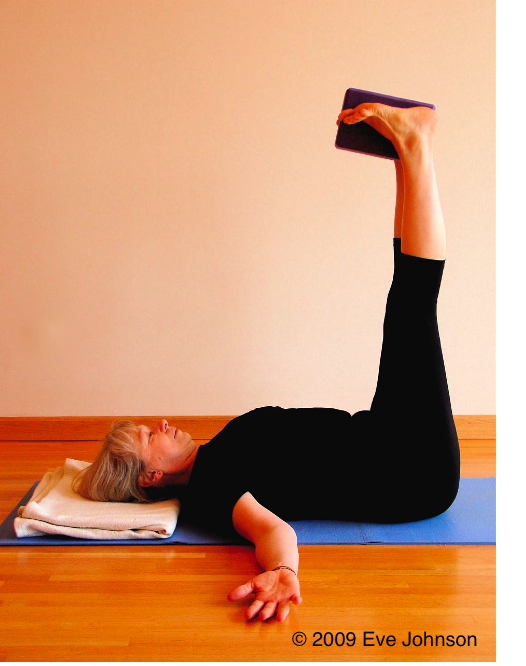Every once in a while I read a description of Iyengar yoga that says something on the lines of: “This style of yoga uses props to make the poses easier and more accessible.”
Oh no, dear hearts.
Indeed, there are times when a cushy bolster, a stack of blankets or a well-placed chip foam block hastens us off to yoga heaven.
In other cases, such as height under your shoulders in shoulder stand, the props are there for safety, specifically to protect the natural curve of your neck.
But most often, Iyengar yoga uses props for clarity, not comfort. Sometimes it’s the clarity provided by correct alignment. Sometimes a prop makes things clear by providing resistance to work against.
That’s just what’s going on with this week’s Five-Minute Yoga Challenge.
It’s Urdhva Prasarita Padasana, (upward stretched out foot pose) with a dense foam brick between your feet.
Safety note: Be sure to use a foam yoga brick and not a wood brick. Losing your grip on a wood brick could have dire consequences.
Lie down on your back with a folded blanket under the back of your head. Draw your knees in to your chest and put a dense foam yoga brick between your feet. Line up the long side of the brick with your inner arches, so you can squeeze the sides of your big toes and your inner ankles – not your inner heels – into the brick.
Now straighten your legs and bring them into a 90-degree angle to the floor.
People with flexible hamstrings can easily bring their thighs past 90 degrees. Here’s a clue: if it’s no work at all to hold your legs up, they are not at 90 degrees. Move them further away from your face, until you feel your abdominal muscles engage.
If you’re in the tight hamstring camp, you won’t be able to bring your straight legs to 90 degrees, so you’ll feel the abdominal work right away – usually far too intensely to be able to pay attention to how your legs are working.
The solution: lie down and find the distance from the wall where your heels can press into the wall and your legs can be straight with a strong and yet workable hamstring stretch. Then place the brick between your feet.
Once you’ve found your working place, roll your front thighs in.
Open the backs of your knees. Squeeze into the brick with the sides of your big toes and your inner ankles, and push the balls of your big toes toward the ceiling. Spread your toes.
Pull your hamstrings down toward your buttocks. Pull your front thighs toward your hip creases. Then, from the tops of your front thighs, near your hip creases, press toward the backs of your thighs.
Look at your knees to make sure they still face evenly forward. If they are rolling toward each other, lengthen the backs of your knees. Make the outer back knee long, and press the outer back knee straight back.
Look at your inner arches and try to move them slightly further away from your face than your outer arches.
Stay from 30 seconds to two minutes, breathing normally.
Bend your knees, relax your lower back, and repeat.
Benefits: With a block between your feet, you can intensify the action of the legs, the same actions that happen in every standing pose in which the legs are parallel. You will particularly feel the front thighs firming and the front upper thighs rolling in.
Building your strength in this pose will build your stamina in standing poses. It will also strengthen your back and tone your abdominals. When you rotate your front thigh inward, you will activate your psoas muscles.
Sequence: Working your legs in this way is a great preparation for inversions and for standing poses. You’ll also find it useful in downward dog.
If you’re taking this practice on as the one five-minute block you can devote to practice in a day, try setting up fairly close to the wall. Do your active work in the pose, and when you’re done, rest for a minute or two with your back relaxed on the floor and your legs up the wall.
Ouch: If your shoulders and neck feel strained, add an extra layer of blanket under your head.
If your lower back feels pinched or strained, try practicing this leg action with your legs up the wall.
Keep your heels at the wall as you work on the actions.
Sanskrit Corner: Say: OORD-vah pra-sa-REE-tah PAD-asanna. Urdhva means upward. Prasarita means extended or stretched. Pada means foot. Asana means pose.
Photo by Chika Watanabe, courtesy Flickr Creative Commons.
If this was your kind of post, you might also like:
Use a Long Strap to Put Your Shoulders in their Place






Comments on this entry are closed.
Thanks for the idea, which I might try before I go to bed tonight. Two comments:
1. Do you have any tips on engaging abs without working the psoas? In some ab-strengthening poses, I find that my psoas kicks in first. And the last thing I need are tighter psoas muscles!
2. What do you think about placing the block lower, eg between calves/shins, between knees, between thighs? Does that change the exercise, in your opinion?
Musu must weigh 30 pounds. I am a big fan of the feline species, and I find this quite disturbing! Cat cruelty!
Hey YogaSpy,
If you don’t rotate the upper thighs in, the psoas shouldn’t engage. Then I think you’d be working the transverse abdominals, but I’m by no means certain of that. As for moving it lower, I’d have to try it. What I like about the brick between the feet is that you get much more awareness into the feet – especially if you can keep the inner ankles on the brick and the heels moving away from it. And the foot action seems important to me.
Yes, that is one fat cat. My niece saw the pictures and said that he/she was more in need of cardio than yoga.